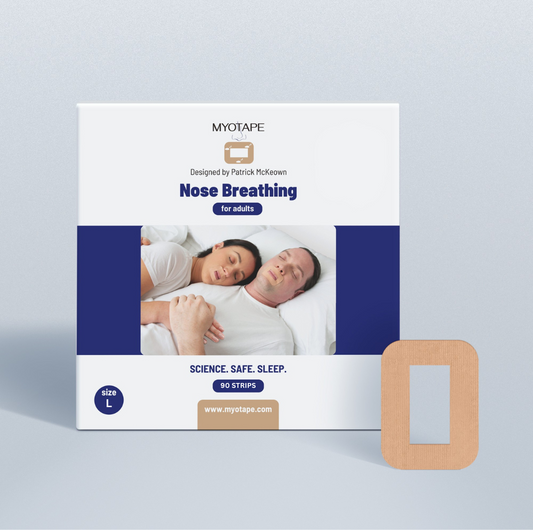Asthma is a chronic respiratory condition characterized by inflammation and narrowing of the airways, leading to breathing difficulties and other symptoms. Recent studies highlight the significant role that breathing habits, specifically nasal and mouth breathing, play in the management and exacerbation of asthma symptoms.
This article reviews key information and studies that explore the relationship between breathing habits and asthma, providing insights into how improving nasal breathing can benefit asthma sufferers and the adverse effects of mouth breathing on asthma.
In their book, Nasal Physiology and Pathophysiology of Nasal Disorders, Bartley and Wong (2013) stated that the nose and lungs form a single, unified airway. This means that where inflammation is present, it can travel from the nose to the lungs and from the lungs to the nose.
This is one reason people with asthma experience elevated levels of nasal congestion. The normal response to a stuffy nose is to begin breathing through the mouth. This, however, increases breathing volume, draws cold, unfiltered, dry air into the airways, and makes the symptoms of asthma worse. Habitual mouth breathing also affects sleep and causes or contributes to stress.
In addition, a substantial 2016 study published in Allergy examined the impact of mouth breathing on asthma. Researchers analyzed data from 9,804 people in Nagahama City, Japan, to clarify the association between mouth breathing and asthma morbidity, while considering the effect of allergic rhinitis (Izuhara et al., 2016).
Key Findings from the Nagahama Study
Increased Asthma Morbidity: Mouth breathing was reported by 17% of the population and was independently associated with increased asthma morbidity. Asthma morbidity refers to the frequency and severity of asthma symptoms and attacks. The odds ratio (OR) for asthma morbidity was 1.85 for mouth breathers and 2.20 for those with allergic rhinitis. When both conditions coexisted, the OR increased to 4.09.
Mouth Breathing in Non-Asthmatics: In individuals without asthma, mouth breathing was linked to higher sensitivity to house dust mites, higher blood eosinophil counts, and lower lung function. Eosinophils are a type of white blood cell that increases in response to allergic inflammation.
Increased Sensitization: Mouth breathing may increase asthma morbidity by increasing sensitization to inhaled allergens. Sensitization refers to the process by which the immune system becomes more reactive to a substance, leading to allergic responses.
Finally, a study published in the European Respiratory Journal investigated how asthmatics and healthy individuals respond to increased nasal resistance, exploring how mouth breathing could affect lung function (Hallani et al., 2008).
The study found that habitual mouth breathing reduced lung function in people with mild asthma and exacerbated the symptoms of acute asthma. This is because mouth breathing leads to greater exposure to non-conditioned air and contributes to the severity of broncho-constrictive exacerbations (narrowing of the airways).
What Does This Mean for You?
First, nasal breathing is crucial. Breathing through the nose is essential because it filters, warms, and humidifies the air before it reaches the lungs. This helps reduce the risk of asthma symptoms and attacks. Conversely, habitual mouth breathing bypasses the nose's protective functions, leading to increased exposure to cold, dry, and unfiltered air. This can worsen asthma symptoms and lead to more frequent and severe asthma attacks.
From the Nagahama study, it was shown that mouth breathing is associated with higher asthma morbidity, meaning more frequent and severe asthma symptoms. This is especially true for individuals who also have allergic rhinitis. Mouth breathing can also increase sensitization to inhaled allergens, making the immune system more reactive to substances like house dust mites. This leads to higher allergic inflammation and worsens asthma symptoms.
Also from the same study, it can be deduced that even in individuals without asthma, mouth breathing can lead to higher sensitivity to allergens, increased allergic inflammation, and reduced lung function. This suggests that mouth breathing is harmful to overall respiratory health, not just for asthmatics.
If you're an asthmatic struggling with mouth breathing, our live clinic by renowned breathing expert, Patrick McKeown can help. Learn techniques to switch to nasal breathing, improve lung function and reduce asthma symptoms. Join our Live Clinic for Asthma and Respiratory Conditions and empower your respiratory health today!
You can also use our mouth tapes, which have been scientifically designed to encourage nasal breathing among asthmatics. Our gentle and safe mouth tapes are effective in promoting nasal breathing while sleeping and during the day. Visit the MyoTape store to find out more.
References:
Bartley, James, and Conroy Wong. “Nasal Pulmonary Interactions.” In Nasal Physiology and Pathophysiology of Nasal Disorders, pp. 559-566. Springer, Berlin, Heidelberg, 2013. https://link.springer.com/chapter/10.1007/978-3-642-37250-6_37
Hallani, M., J. R. Wheatley, and T. C. Amis. “Initiating oral breathing in response to nasal loading: asthmatics versus healthy subjects.” European Respiratory Journal 31, no. 4 (2008): 800-806. https://pubmed.ncbi.nlm.nih.gov/18032447/
Izuhara, Y., Hisako Matsumoto, T. Nagasaki, Y. Kanemitsu, K. Murase, I. Ito, T. Oguma et al. “Mouth breathing, another risk factor for asthma: the Nagahama Study.” Allergy 71, no. 7 (2016): 1031-1036. https://onlinelibrary.wiley.com/doi/abs/10.1111/all.12885








